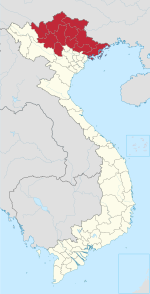Hà Giang
Hà Giang
Thành phố Hà Giang | |
|---|---|
Hà Giang | |
| Area | |
| • Total | 135.33 km2 (52.25 sq mi) |
| Population (2019) | |
| • Total | 55 559 [1] |
| Climate | Cwa |
| Website | www.hagiangcity.gov.vn (Vietnamese) |

Hà Giang (
History
Up until the 19th century the settlement of
On August 12, 1991, the province of Hà Giang was re-established and separated from
On September 27, 2010, Hà Giang town was officially upgraded into a provincial city.
In March 2014, the urban development project type II was approved by the Prime Minister in Decision No. 190, which includes the provinces of
Culture
Mong Village: Then Pa (Dong Van, Ha Giang) Located right at the foot of the Lung Cu National Flagpole, Lung Cu commune (Dong Van, Ha Giang), Mong Then Pa village still retains almost intact many traditional features of the Mong people such as lifestyle, walled houses with tiled roofs. yin and yang... This village for hundreds of years lies quietly next to Dragon's Eye Lake, becoming an ideal destination for tourists who love peace, getting rid of all the hustle and bustle of life.[3]
Climate
Like most of northern Vietnam, Hà Giang has a dry-winter humid subtropical climate (Köppen Cwa).
| Climate data for Hà Giang | |||||||||||||
|---|---|---|---|---|---|---|---|---|---|---|---|---|---|
| Month | Jan | Feb | Mar | Apr | May | Jun | Jul | Aug | Sep | Oct | Nov | Dec | Year |
| Record high °C (°F) | 30.3 (86.5) |
33.4 (92.1) |
35.3 (95.5) |
38.3 (100.9) |
40.1 (104.2) |
38.8 (101.8) |
39.5 (103.1) |
40.7 (105.3) |
38.4 (101.1) |
35.1 (95.2) |
33.5 (92.3) |
31.1 (88.0) |
40.7 (105.3) |
| Mean daily maximum °C (°F) | 19.5 (67.1) |
21.1 (70.0) |
24.3 (75.7) |
28.3 (82.9) |
31.5 (88.7) |
32.3 (90.1) |
32.6 (90.7) |
32.8 (91.0) |
31.8 (89.2) |
28.9 (84.0) |
25.3 (77.5) |
21.6 (70.9) |
27.5 (81.5) |
| Daily mean °C (°F) | 15.6 (60.1) |
17.2 (63.0) |
20.4 (68.7) |
24.1 (75.4) |
26.7 (80.1) |
27.7 (81.9) |
27.8 (82.0) |
27.6 (81.7) |
26.5 (79.7) |
23.9 (75.0) |
20.3 (68.5) |
16.9 (62.4) |
22.9 (73.2) |
| Mean daily minimum °C (°F) | 13.3 (55.9) |
14.9 (58.8) |
17.9 (64.2) |
21.2 (70.2) |
23.4 (74.1) |
24.6 (76.3) |
24.7 (76.5) |
24.5 (76.1) |
23.3 (73.9) |
21.0 (69.8) |
17.2 (63.0) |
14.0 (57.2) |
20.0 (68.0) |
| Record low °C (°F) | 1.5 (34.7) |
4.9 (40.8) |
5.4 (41.7) |
10.0 (50.0) |
15.2 (59.4) |
17.3 (63.1) |
20.1 (68.2) |
20.3 (68.5) |
14.3 (57.7) |
9.8 (49.6) |
6.5 (43.7) |
2.0 (35.6) |
1.5 (34.7) |
| Average rainfall mm (inches) | 40.1 (1.58) |
38.8 (1.53) |
64.6 (2.54) |
106.2 (4.18) |
294.6 (11.60) |
430.2 (16.94) |
545.3 (21.47) |
414.7 (16.33) |
240.9 (9.48) |
153.6 (6.05) |
84.1 (3.31) |
42.2 (1.66) |
2,455.4 (96.67) |
| Average rainy days | 11.4 | 10.4 | 12.0 | 14.8 | 17.9 | 20.8 | 24.1 | 21.5 | 15.6 | 13.5 | 10.1 | 8.3 | 180.3 |
| Average relative humidity (%)
|
84.9 | 83.9 | 82.8 | 81.8 | 80.5 | 84.5 | 85.9 | 85.7 | 84.2 | 84.0 | 84.1 | 84.0 | 83.8 |
| Mean monthly sunshine hours | 54.9 | 56.4 | 68.0 | 107.6 | 158.0 | 132.5 | 156.5 | 172.1 | 161.4 | 124.8 | 108.8 | 88.9 | 1,391 |
| Source: Vietnam Institute for Building Science and Technology[4] | |||||||||||||
Administration
The following administrative units are recognized as part of Hà Giang city:
- Trần Phú Ward
- Minh Khai Ward
- Nguyễn Trãi Ward
- Quang Trung Ward
- Ngọc Hà Ward
- Phương Thiện
- Phương Độ
- Ngọc Đường
Economy
Hà Giang province is a highly mountainous region. Much of the province is too mountainous for agriculture, leaving much of the land covered by forests. Hà Giang's central plateau is good for growing plums, peaches, and persimmons, which the province exports. Tea is also grown.
Hà Giang is one of the poorest provinces of Vietnam. Traditionally, the vast majority of its economic activity revolved around agriculture and forestry, but in recent years, there have been attempts to establish a manufacturing industry. Infrastructure in Hà Giang has seen improvement, but remains poor – roads, schools, and health services are less developed than in many other parts of Vietnam. Since the designation of Dong Van Karst Plateau Geopark in 2010, the tourism industry has been growing.
Demographics
Many people in Hà Giang belong to one of Vietnam's ethnic minorities. Aside from the Viet (or
References
- ^ ISBN 978-604-75-1532-5.
- ^ Tim Doling North East VietNam:hee hee hee haaawwwww mountains and ethnic minorities 2000 Page 98 "Throughout the medieval and early modern period, the largest settlement in the area was at Vị Xuyên, south of Hà Giang, but under the Nguyễn Dynasty (1802–1945) the town of Hà Giang – located on the east bank of the Lô River in what is now the Trần Phủ District- began to grow steadily in size. In 1842 Hà Giang was incorporated into the new Tuyên Quang Province, which at that time stretched north as far as the Chinese border. Following the French conquest of the area in 1886, Hà Giang became an important colonial military outpost ..."
- ^ vietnamtourism.gov.vn https://vietnamtourism.gov.vn/post/54259. Retrieved 2024-01-13.
{{cite web}}: Missing or empty|title=(help) - ^ "Vietnam Institute for Building Science and Technology" (PDF).

